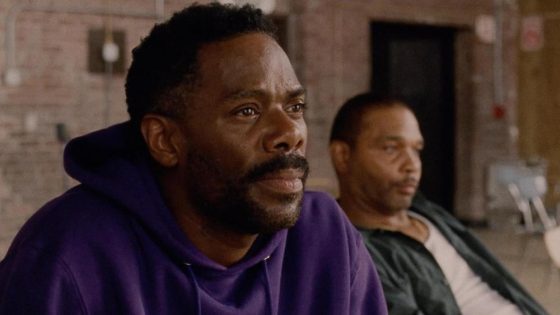Red carpets are hectic places. Even for seasoned actors, they can be disorienting and frustrating. At a movie premiere, no moment better epitomizes a red carpet’s chaos than the “group photo,” when hordes of publicists and studio staff wrangle, like cats, a dozen or more movie stars and gabbing producers to stand in one place and smile.
But on a red carpet in Brooklyn Wednesday evening, at the premiere for the film “Sing Sing,” Colman Domingo, the film’s star, assembled his cast with ease. Amid the clamor and usual dysfunction, he usurped the studio staff and halted the photographers. He collected the actors into a photo-ready group, turned his back to the cameras, and gave the cast a pep talk before the photos began. The red carpet went quiet.
“This is a strong image, and we want the world to see it. Stand up and hold on to each other,” Domingo said. “Remember, we’re strong, esteemed, respected, loved and filled with grace. We’re going to be regal,” he proffered. “Hold your head high. Let’s do it.”
He was saying so because his ensemble cast in “Sing Sing,” save for the Oscar-nominee Paul Raci, are all formerly incarcerated actors and alumni of the prison arts program, Rehabilitation Through the Arts. For them, the lights and cameras of a movie premiere were brand new.
Developed in partnership with RTA and directed by Greg Kwedar, “Sing Sing” follows a prison theater troupe who endeavor to stage their first comedy. In doing so, they depict how prison art programming offers incarcerated men (and women) a powerful escape and cathartic medium. Co-produced by Domingo and distributed by A24, the film is inspired by the real-life friendship of RTA alumni John “Divine G” Whitfield (portrayed by Domingo) and Clarence “Divine Eye” Maclin, who plays himself in the film and first acted as part of an RTA program at Sing Sing itself.
Paul Raci, Clarence Maclin, Colman Domingo and Sean ‘Dino’ Johnson.
Kristina Bumphrey
On the red carpet, Domingo embraced Maclin, who’d worked to develop the film with Kwedar for eight years, and let the photographers file in.
“To amplify whatever I can, especially now, is really important to me,” Domingo, whose leading turn in “Rustin” was nominated for an Oscar last year, told Variety at the premiere. “Now that I have more equity in Hollywood, I feel like I have agency to say ‘Hey, look at this story. I chose to put my energy behind this.’”
“Sing Sing,” as Domingo describes, is far more than a nice story with novel casting: It sends up a flare to a flailing movie business. “Sing Sing” champions a model that director Kwedar dubs “community-based filmmaking,” which strives to employ the real locations and people which the film depicts. (“Sing Sing” was filmed in 2022 at the Downstate Correctional Facility in New York, weeks after the prison was decommissioned.) It also pioneers a new economic model: The cast of “Sing Sing”—Domingo and all—were paid the same rate, based on SAG weekly or daily minimums. Everyone working on the film was also given equal equity and profit share in the film’ earnings.
“It’s a model that can shift how a production operates, to make sure the film is equitable above and below the line,” Domingo told Variety. “I don’t know if it works for every story, but there are elements of this that I’d like to see implemented across the industry.”
For Kwedar, Hamlet’s question—whether we are forever the prisoner of our actions—isn’t only a metaphor for the movie’s subject: It’s also a question for the film business. His movie interrogates the labor systems that undergird filmmaking, and asks—mixing Shakespeare and Marx—whether actors as labor are made by their art or by their financiers.
“You have to question every step of the process,” Kwedar told Variety on Wednesday. “We’ve done this financial model before on smaller projects, but could it work with a 50-person crew, 25-member cast and institutional backer? The answer is yes,” he said. “We have over 80 profit participants in our half of the business. That’s our whole cast and crew. In a story like this, which centers formerly incarcerated men who have been taken advantage of by systems, they have literal ownership over their own story.”
Dressed in a snappy summer suit and standing in the theater lobby of the Brooklyn Academy of Music, he also understood a key irony: “Yes, this is our New York premiere, but we had another premiere this week, where we showed the film inside of Sing Sing,” Kwedar told Variety. “It was the most profound theatrical experience of my life. We all walked out of the gate that night and cherished the fresh air, but our audience didn’t.”
That gets to the heart of it: For most of the cast members—some of whom, in showing the film, reentered the same prison they’d vowed never to see again—“it’s about freedom and creativity,” said Sean “Dino” Johnson, an actor in the film and RTA alumni.
“This is something I’m proud of,” he told Variety. “It gives me joy. That’s all it is. I never thought I’d be in a film like this, and it’s a dream come true. Like the characters do in the film, you have to leave the nonsense outside the door. You come in here? It’s a free space.”
Source Agencies



